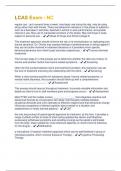Exam (elaborations)
LCAS Exam - NC (100% correct and graded A+)
- Course
- Institution
regular use - up to several times a week. may begin use during the day. may be using along rather than with friends. There are behavioral indicators in this phase of addiction, such as a decrease in activities, declined in school or work performance, and greater interest in use. May use to manip...
[Show more]



